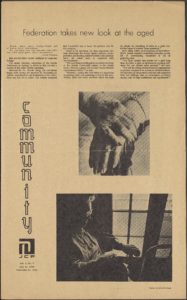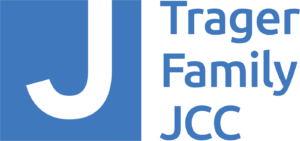
The first known front page of Community – dated September 26, 1973 – can be found in the new Community Newspaper Digital Archives, which will be debuted at a virtual program on Monday, May 10. Back issues of the paper through the 1990s have already been digitized, and the work continues. (Photo provided by the Filson Historical Society)
By Lee Chottiner
Community Editor
After two years of work, a browsable, searchable platform for past issues of Community is ready to be debuted online.
The Filson Historical Society and the Jewish Community of Louisville will host a virtual program for the Community Newspaper Digital Archives at 7 p.m., Monday, May 10.
The platform will give Jewish Louisville a new and powerful tool to research the history of the community in general or segments of it: synagogues, agencies, historic dates and individuals, or just someone’s bar mitzvah or wedding announcement.
Abby Glogower, the Filson’s curator of Jewish collections, and Danielle Spalenka, its curator of digital projects, will outlined the new platform – how it was built, how it will work – while Dick Clay, president and CEO of the Filson, and Sara Klein Wagner, president and CEO of the JCL, will speak about the partnership between the two organizations.
“We were looking for something that would be big and exciting,” Glogower said in an interview with Community, “kind of like a challenge for the Filson, a nice overture to the Jewish community and something that people could really enjoy in a lot of different ways.”
The program will include a virtual tour of the new platform, and Q&A from the participants.
The process, which has been under way since 2019, is 70 percent complete with 13,166 pages digitized, but Glogower said the Filson and JCL wanted to roll it out now to generate interest in the project and give people a useful learning resource while they are at home during the pandemic.
The Filson has contracted New York-based Hudson Archival to digitize the papers and build the files into the platform.
It also has chosen Viridian to host the platform, the same outfit that hosts online newspaper collections from the National Library of Israel.
So far, the Filson, which is paying for the project, has put up $16,000 for digitization, $10,500 to host the platform, and $4,000 to back up all the materials that are online – “cold storage,” Glogower calls it.
She estimates another $6,000 will be needed to finish the digitization, plus $6,000 per year to keep the platform online and $1,500 to finish the back-up.
In all, the Filson has spent over $30,000 on the project and anticipates spending another $10,000 to finish it.
“A lot of people don’t really understand what goes into archiving and preservation – all the labor and costs that are involved,” Glogower said. “It’s not just an institutional version of chucking things chaotically in an attic or basement.”
Glogower and Hudson overcame certain hiccups to get the project to this point. For one, Hudson was forced to shut down for a period due to COVID, slowing its progress.
For another, Glogower found putting together a complete set of printed issues of Community harder than she expected. The JCL had two sets, neither of which was complete.
“I had to go page by page, through thousands of pages, to make sure we were assembling one complete set for the digitizer,” she said.
The platform can be expanded in the future to add digitized issues of the YMHA Chronicler – the forerunner of Community – and the Kentucky Jewish Post & Opinion, but there are some legal issues to sort out. While the JCL owns the rights to the Chronicler, the rights to the P&O rest with the Indianapolis-based Jewish Post & Opinion.
For now, the platform will host only Community.
Spalenka, the digital projects curator, said the project is major step forward in the Filson’s work in digitization.
“It really launched the Filson’s digital preservation program,” she said. “Just because you digitize something doesn’t mean those digital files are preserved. We have been digitizing materials for years but something this big and important prompted us to ensure long-term access and stability that follows digital preservation standards in the field.”
She hopes Digital Community will be a means to teach its users that digitization means more than just scanning items.
“This project involved years of work,” Spalenka said, “but the end result is truly incredible.”
The first issue of Community, as a newspaper, rolled off the presses in September 1973. At first, the paper came out twice a month, but eventually moved to a monthly circulation.
Digital Community will be accessible through the Filson and Jewish Louisville websites once it is rolled out. Access will be free.
Glogower said the Filson’s partnership reflects the kind of relationship it hopes to establish with communities around the city.
“What this is really about long term was partnership,” she said, “we’re partners in preservation.”
Community Editor Emeritus Shiela Steinman Wallace initiated the digitization project to chronicle the history of Jewish Louisville. A committee was assembled to move the project forward.
Want to see?
Digital Community can be accessed at filsonhistorical.org/collections/jewish-collections/


